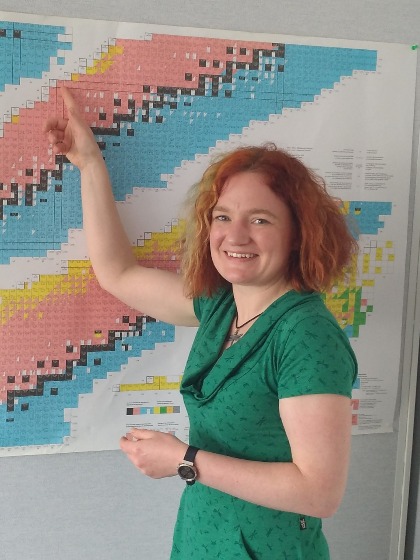J. (Julia) Even, Prof

Research interests
Julia Even's research focuses on exotic, atomic nuclei far away from the valley of stability. In particular the interest lies on the heaviest nuclei and nuclei relevant for the synthesis processes of heavy element.
Together with her team she develops new experimental setup to produces, separate, and study these nuclei. In particular, the team wants to measure the nuclear masses with highest precision to get direct access to the nuclear binding energies.
Currently, the group of Julia Even works on three main projects that have been funded by NWO and ERC.
In 2022, the NWO ENW-XL grant "Probing the phase diagram of quantum chromodynamics" has been awarded to a consortium of researchers from the University of Utrecht, University of Amsterdam, Nikhef and University of Groningen. The consortium will look at the strong force from all angles. Julia Even is one of the co-PI. She and her team will in particular study the masses of neutron-rich nuclei and test their impact on the simulation of kilonovae and the rapid neutron capture process.
In 2018, Julia Even has been awarded with an ERC Starting grant for the NEXT project. NEXT focuses on "heavy, Neutron-rich, EXotic nuclei produced in multi-nucleon Transfer reactions".
Multi-nucleon transfer reactions using actinide targets hold the potential for the discovery of new isotopes in the transfermium region. These will provide access to information on the evolution of nuclear shell structure and fission half-lives in the heavy element region. Xe-136 induced transfer reactions with lead or platinum can provide access to the closed neutron-shell N=126, the 3rd waiting point of the astrophysical r-process. Due to the large angular distribution of the transfer products, sample preparation for mass measurements and decay spectroscopy studies remains challenging a. So far, no separator dedicated to the production of heavy elements with multi-nucleon transfer reaction has been build.
In the NEXT project, a solenoid spectrometer will be combined with a Multi Reflection-Time of Flight Mass Spectrometer (MR-ToF MS) in order to overcome experimental limitations. The setup will be installed at the AGOR cyclotron at PARTREC in Groningen. The solenoid spectrometer provides a large angular acceptance for transfer products. With help of the MR-ToF MS masses in the region around mendelevium towards the subneutron shell closure N=162 and exotic nuclei around the 3rd waiting point of the r-process will become accessible.
In 2017, Julia Even has been awarded with a NWO Natuurkunde Projectruimte to "catch doubly magic tin-100". Tin-100 is located at the proton-drip line near the end of the rapid proton capture process. Within the project, a new chemical separation technique is under development to prepare clean sample for high precision mass measurements with SHIPTRPAP at GSI, Darmstadt.
